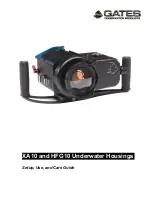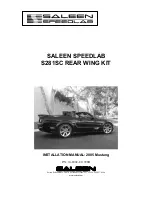
62
Learning does not begin until the engine is warmed up. Coolant temperature must be above
140° F for learning to begin.
There are various qualifying conditions that must be satisfied for learning to take place. This
prevents the ECU from learning from inappropriate feedback. Many of the learning qualifiers
have to do with making sure the engine is in a steady state condition – no rapid changes. The
“Learning” LED displayed on the hand-held’s Live Dashes will indicate when learning is
enabled. This can be used as feedback to give the driver a feel for when the ECU will or will
not learn.
Learning will take place automatically as the vehicle is driven. No special procedures need to
be followed. Just drive normally. However, it is possible to help speed up the learning
process on a fresh installation. A good method is to open the throttle a small amount and hold
the pedal steady. Let the vehicle accelerate up through the gears. Hold the pedal steady as
long as reasonably possible. Slow down and repeat the process several times using larger
throttle openings each time. It is NOT required that you go through this process with every
throttle position. Don’t do anything to risk your safety or that of other motorists!
While the ECU is still going through the initial learning process, you may discover driving
conditions where the engine is not perfectly happy. This is a natural part of the learning
process. Unless the engine is really unhappy, don’t try to avoid those conditions. Instead,
gently return there and allow the ECU to learn what the engine wants. It should soon feel
much better.
Changes made to the tune in the ECU – through learning or hand-held adjustments – are held
in short-term memory within the ECU until the next key-off. At that time, the changes are
saved into long-term memory. The “BATTERY POS” and “BATTERY NEG” wires must be
connected directly to the battery. If all power (“12V SWITCHED” and “BATTERY POS”) is
cut to the ECU at one time, any new learning will be lost. Once a proper power down
sequence has occurred (when the ECU’s POWER LED has gone out approximately 5-10
seconds from key-off), the battery leads can be disconnected, or the ECU can be disconnected
from the wiring harness if necessary. Once saved into long-term memory, the tune can remain
in an un-powered ECU for years.
The EZ-EFI
®
system is intended for naturally aspirated engines only – no turbos or
superchargers.
Along with air/fuel ratio and other fueling-related factors, ignition timing also plays a large
role in how an engine runs. If the EZ-EFI
®
is not being used to control ignition timing, be
sure that the ignition system has an appropriate timing curve. Don’t forget to consider factors
like mechanical and vacuum advance. For example, if the engine has a surging idle, it might
want a richer (lower number) Idle Air/Fuel target. Or it might want less timing. Or, the cause
could be oscillating timing caused by overly light springs in the distributor. Another example
would be if idle speed often dips and threatens to stall. The engine may prefer a different Idle
Air/Fuel target. It could also be that more base timing or more vacuum advance would give
the engine a more robust idle. These examples happen to be about idle, but of course, timing
affects all modes of engine operation – tip-in, acceleration, cruise, etc. The point is that
air/fuel ratio and timing both need to be optimized for the engine to run at its best.
If you ever notice the TPS reading is not 0 at idle, make sure that nothing is interfering with
the throttle linkage and preventing it from returning to its fully closed position. If the throttle
linkage is in its fully closed position (resting on the idle screw) and TPS is still reading above
Содержание 30400-KIT-EZ-EF
Страница 11: ...11 In Tank Fuel Pump System Layout...
Страница 17: ...17 In Line Pump Fuel System Layout...
Страница 56: ...56 Dash 1 Dash 2 Dash 3...
Страница 69: ......
Страница 70: ......









































